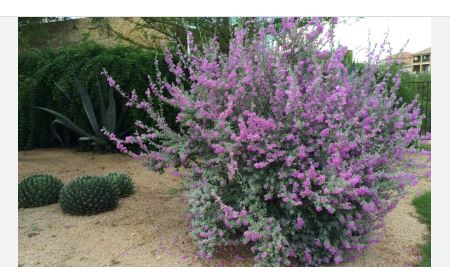
Texas Sage, scientifically known as Leucophyllum frutescens, belongs to the Scrophulariaceae family, which includes plants like snapdragons and mulleins. It is often mistakenly referred to as a true sage (Salvia spp.), but it is more closely related to plants like the butterfly bush. Its common names include Purple Sage, Texas Ranger, and Cenizo, reflecting its distinctive silvery foliage and the vibrant purple flowers it produces.
The history of Texas Sage is deeply intertwined with the cultures of the Southwestern United States and Northern Mexico, where it has been a part of the landscape for centuries. Indigenous peoples have used this plant for its drought-resistant qualities and for ornamental purposes, appreciating its beauty in an otherwise arid environment. Its popularity in modern landscaping, especially in xeriscaping, has grown due to its ability to thrive with minimal water, symbolizing sustainability in garden design.
Native to the arid regions of the southwestern U.S., particularly Texas, New Mexico, and parts of Arizona, as well as Northern Mexico, Texas Sage thrives in the Chihuahuan and Sonoran Deserts. It’s found in dry, rocky, or sandy soils of scrublands, hillsides, and arroyos, showcasing its adaptability to harsh environmental conditions. This plant’s natural habitat is characterized by full sun, low humidity, and nutrient-poor soils, making it an ideal choice for similar climates elsewhere.
In terms of lifespan, Texas Sage is a perennial shrub, meaning it can live for many years under the right conditions. With proper care, including appropriate pruning to maintain shape and health, it can last for decades, becoming an enduring feature in landscapes. It typically grows to a height of 3 to 8 feet, depending on the variety and its growing conditions, offering both beauty and structure to gardens.
When considering USDA Hardiness Zones, Texas Sage is hardy in zones 8 through 11. This range indicates its tolerance for both heat and cold, although it prefers the warmer end of this spectrum. In zone 8, it might suffer some frost damage but will usually regrow in spring. In its native zones 9 through 11, Texas Sage is evergreen, maintaining its foliage year-round. In colder areas or during severe winters, providing protection through mulching can help ensure its survival. Its adaptability to various USDA zones makes it a valuable plant for gardeners looking to incorporate drought-resistant, low-maintenance flora into their landscapes.
How To Grow Texas Sage In Pots & Containers
Growing Texas Sage (Leucophyllum frutescens) in pots and containers is an excellent strategy for those looking to enjoy this drought-tolerant, visually appealing plant in limited spaces or where soil conditions might not be ideal. Here’s how to successfully cultivate Texas Sage in containers:
Choosing the Right Pot
Opt for a container that’s at least 18-24 inches wide and deep to accommodate the root system of Texas Sage. The pot should have drainage holes to avoid waterlogging, which this plant dislikes. Terracotta pots can be beneficial for their breathability, but ensure they’re large enough to prevent rapid drying out.
Soil Mix
Use a well-draining potting mix, ideally with a sandy or gritty component to mimic the plant’s natural, arid habitat. A mix of cactus soil, perlite, and a bit of sand will help with drainage while still providing some nutrients. Texas Sage prefers a slightly acidic to neutral soil pH, around 6.0 to 7.0.
Planting
Plant your Texas Sage at the same level it was growing in its previous container, ensuring not to bury the stem. If starting from seeds, they’re quite challenging to germinate, so it’s more practical to use cuttings or young plants from nurseries. Space multiple plants with enough room for air circulation to prevent fungal issues.
Light
Texas Sage thrives in full sun, needing at least 6 hours of direct sunlight daily. Place your container where it gets the most sun exposure, especially in cooler climates to promote healthy growth and flowering.
Watering
Water sparingly, allowing the soil to dry out between waterings. Overwatering can lead to root rot, one of the few real threats to this plant in containers. Once established, Texas Sage is remarkably drought-tolerant, but young plants or those in pots might need more frequent watering until they adapt.
Temperature
This plant loves heat and can withstand temperatures well into the 90s. However, in pots, it’s more susceptible to cold. Protect it from frost by moving the container indoors or to a sheltered area during winter. In hot climates, ensure the pot isn’t sitting in direct, scorching sun all day without some relief.
Fertilization
Texas Sage doesn’t require much feeding due to its adaptation to poor soils. If you fertilize, use a low-nitrogen, slow-release fertilizer once in early spring. Over-fertilizing can lead to leggy growth with fewer blooms.
Pruning
Prune in late winter or early spring to shape the plant and encourage bushier growth. You can also prune after flowering to remove spent blooms and promote new growth. However, be mindful not to cut back too much at once, as Texas Sage doesn’t respond well to severe pruning.
Repotting
Repot every couple of years to refresh the soil and give roots more space. This is best done in spring. If the plant seems too large for easy repotting, you can trim the roots and prune the top growth to fit into a new pot.
Pest and Disease Control
Texas Sage is relatively pest-free, but watch for scale or spider mites. Treat with insecticidal soap or neem oil if you notice any issues. It’s also quite resistant to diseases, but good air circulation helps prevent any potential fungal problems.
Winter Care
In colder zones, Texas Sage in pots may need extra protection. Move the pot to a cool but above-freezing location or insulate it with mulch or bubble wrap. Water sparingly during this dormant period.
Growth Control
Since plants in containers can grow somewhat differently than in the ground, monitor for root-bound conditions which might stunt growth or flowering. If growth seems stunted, it might be time to either repot or divide the plant.